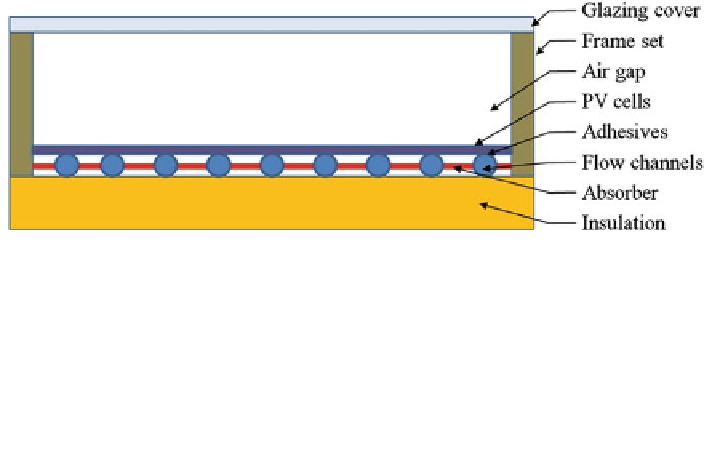Civil Engineering Reference
In-Depth Information
Fig. 3
A focused cross section of typical PV/T module (Zhang et al.
2012
)
g
o
¼
g
th
þ
g
e
ð
1
Þ
Thermal Efficiency of the PV/T Collector (g
th
)
The thermal efficiency (g
th
) of a flat-plate PV/T collector is a ratio of the useful
thermal energy, Q
u
, to the overall incident irradiation, I, and can be written as
g
th
¼
Q
u
I
ð
2
Þ
The heat collected by the flat-plate PV/T collector could either be given as the
coupling result of average mass flow rate (m), heat capacity of flowing medium
(C
p
) and temperature difference of the medium at the collector inlets (T
fi
) and
outlets (T
fo
), as below
Q
u
¼
mC
p
T
fo
T
fi
ð
3
Þ
Or it could be simply expressed by the difference in absorbed solar radiation,
heat loss and produced electrical energy
Q
e
Q
u
¼
A
c
I s
ðÞ
U
L
T
p
;
m
T
a
ð
4
Þ
where A
c
is the collector area; (sa) is transmittance-absorption effort of glazing
cover; U
L
is the overall thermal loss efficient; T
a
is the average air temperature;
and Q
e
is the electrical energy generated from the PV. The parameter T
p,m
, rep-
resenting the mean absorber plate temperature, is difficult to measure or calculate
since it is a complex function of different collector designs, incident solar radiation
and working medium properties. To allow analysis, the equations for a flat-plate
solar collector are modified by the Hottel and Whillier (
1958
) using the fluid inlet
temperature to replace the mean absorber temperature, which has been widely used
in the design and evaluation of solar air and liquid collectors. It should be stressed
that the equations are correlated with the solar collector configuration as shown in
Fig.
4
. If the configuration of the collector is changed, some geometrical param-
eters in the equations may vary correspondingly, while the basic working principle
of the collector remains the same.

